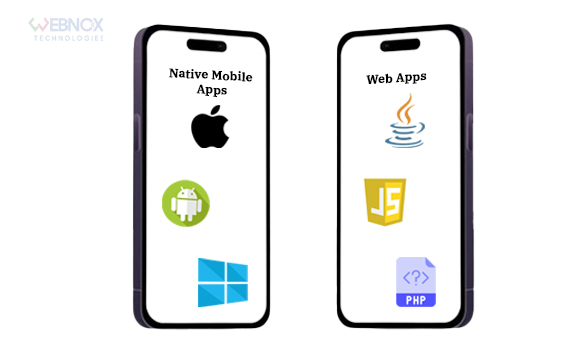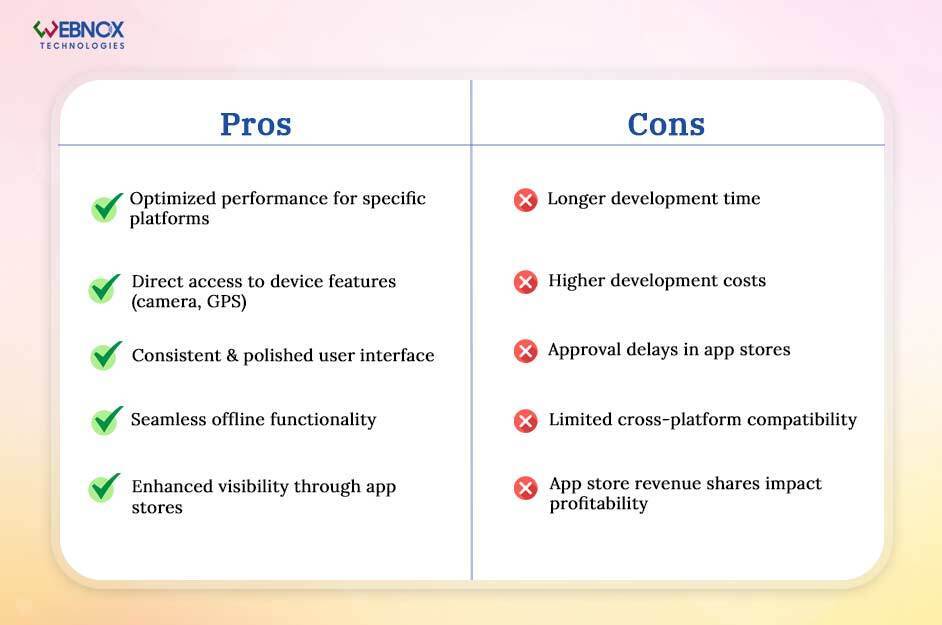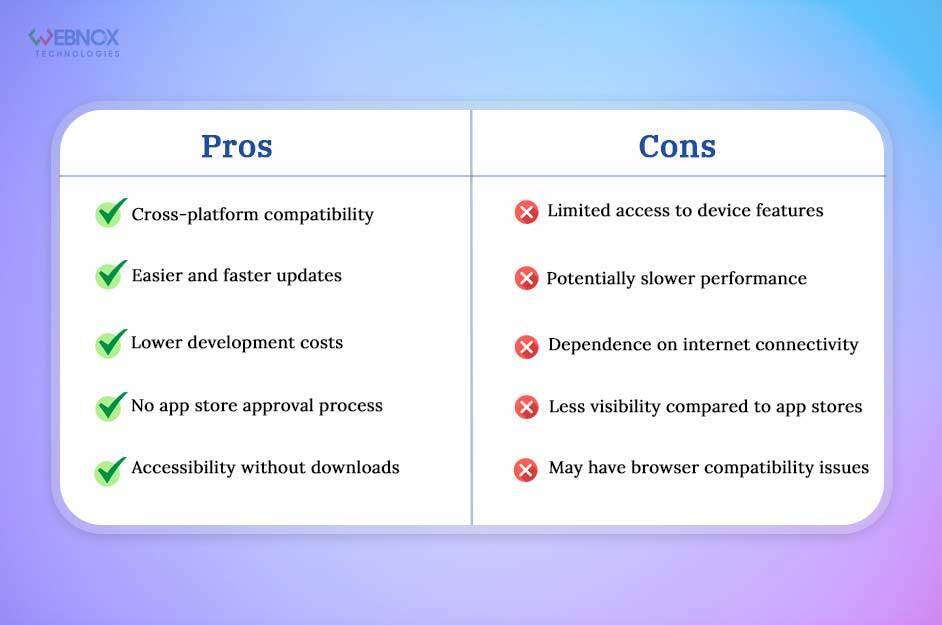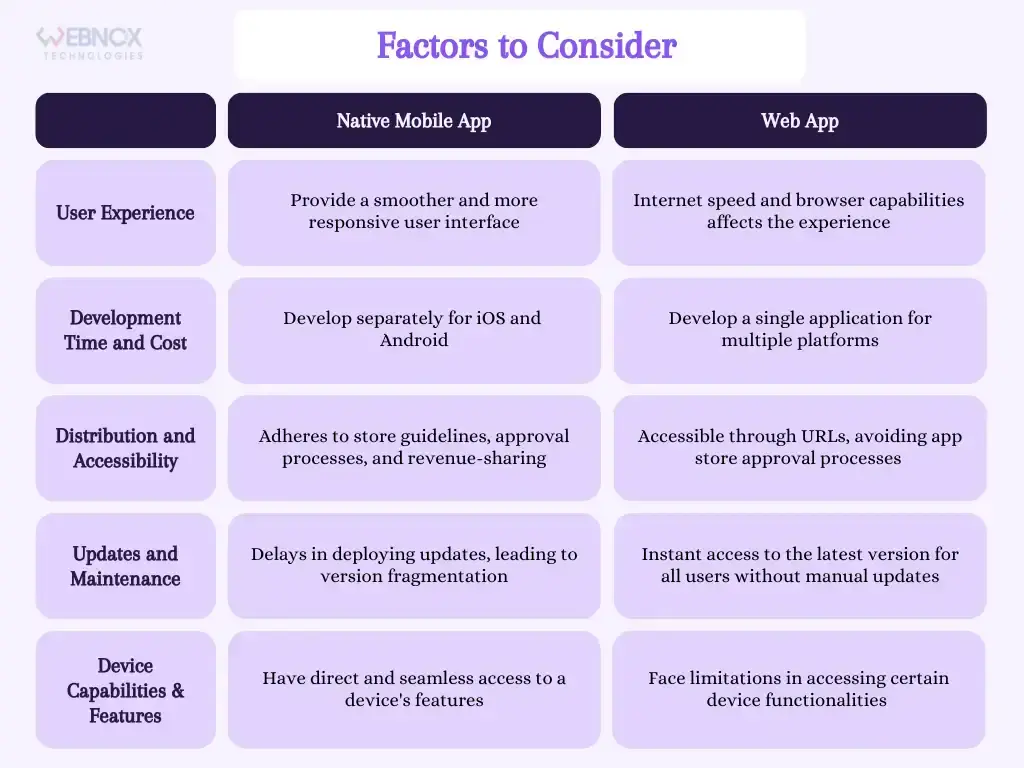Native Mobile Apps vs Web Apps: Determining Which One Is the Best Fit For Your Development Needs

Rathinakumar // 13-12-2023
Introduction
Exploring the world of digital development involves deciding whether to pursue native mobile apps or web apps.So, you’re at a crossroads in your development journey, contemplating whether to go for a native mobile app or a web app for your business. The decision you make here can significantly impact your user experience, development costs, and overall success. In this guide, we’ll walk through a detailed exploration of key considerations to empower you to make an informed decision that aligns seamlessly with your specific development needs.
Understanding the Basics
Native Mobile Apps
Let’s start with native mobile apps. These are applications specifically designed for a particular operating system, such as iOS or Android. They are built using programming languages like Swift for iOS or Java/Kotlin for Android. Native apps are known for their high performance and seamless integration with the device’s features.
Web Apps
On the other hand, web apps are accessed through a web browser and do not need to be downloaded or installed on a device. Web application development is based on web technologies like HTML, CSS, and JavaScript. Web apps offer cross-platform compatibility and can be accessed from any device with a browser.
Pros and Cons Of Native Mobile App
- Native mobile apps are finely tuned to the characteristics of specific operating systems, ensuring they run with maximum efficiency and responsiveness on platforms like iOS or Android.
- These apps have the privilege of directly utilizing hardware features, such as the camera and GPS, enabling developers to create sophisticated functionalities and enhance the overall user experience.
- Native apps adhere to the design guidelines of the respective platforms, resulting in a consistent and polished user interface. This adherence contributes significantly to a seamless and intuitive user experience.
- Native mobile apps are designed to operate seamlessly even in offline environments, catering to users in areas with limited or no internet connectivity. This offline functionality ensures a continuous user experience.
- Challenges include longer development time, higher costs, approval delays, and limited cross-platform compatibility. App stores also impact profitability through revenue shares.

Pros and Cons Of Web App
- Developing web apps allows for writing code once and deploying it across multiple platforms, reducing the need for separate codebases and easing development efforts.
- Web apps can be updated instantly without the need for app store approvals, providing developers with greater agility and allowing users to access the latest features promptly.
- Web app development is often more cost-effective as it involves a single codebase, and these apps are accessible through web browsers, eliminating the need for platform-specific development and enabling a broader user reach.
- Despite their advantages, web apps might face performance issues, especially when handling graphics-intensive tasks, as they rely on browser capabilities that may not be as optimized as native platforms.
- Web apps may have limitations in accessing certain device features, depend on internet connectivity, and may experience lower discoverability compared to native apps available in centralized app stores.

Factors to Consider

1. User Experience
Native Mobile Apps
When it comes to user experience, native apps have a clear edge. They are optimized for the specific platform, offering a smoother and more responsive interface. This is crucial for applications that require high-performance graphics or complex interactions.In addition to performance benefits, native mobile apps have the advantage of utilizing platform-specific features seamlessly, providing users with a more integrated experience. They can leverage device functionalities such as camera access, GPS, push notifications, and gestures, enhancing overall usability.
Web Apps
Web apps, while improving in this aspect, may not match the seamless experience provided by native apps. Factors like internet speed and browser capabilities can impact the user experience. However, advancements in web technologies, such as progressive web apps (PWAs), have narrowed this gap by enabling web applications to work offline, send push notifications, and deliver a more app-like experience. Web apps offer the advantage of cross-platform compatibility, as they can be accessed through browsers on various devices. This eliminates the need for separate development for each platform, streamlining the development process and reducing costs.
Your Decision:
Your users are the lifeblood of your business, and their satisfaction is paramount. If your business involves delivering content-rich experiences, intricate graphics, or demanding interactions, native apps provide a level of user experience that can significantly enhance customer satisfaction and loyalty. Remember, in today’s competitive landscape, the quality of user experience can be the differentiator that sets your business apart.
2. Development Time and Cost
Native Mobile Apps
Developing native apps for both iOS and Android requires separate codebases, which can increase development time and costs. This dual-platform approach demands specialized expertise, as developers need proficiency in both Swift or Objective-C for iOS and Java or Kotlin for Android. The intricacies of managing and synchronizing these separate codebases may extend the development timeline. Additionally, the need for adherence to each platform’s guidelines can contribute to a polished and platform-specific design, enhancing user engagement.
Web Apps
Web apps, being cross-platform by nature, can save time and money as you’re essentially developing one application for multiple platforms. This not only streamlines the development process but also simplifies maintenance, as updates can be implemented server-side without requiring users to download new versions. The use of common web technologies like HTML, CSS, and JavaScript further accelerates development, as developers can leverage existing skills. However, it’s essential to note that achieving feature parity with native apps may still require additional effort, and certain platform-specific functionalities might not be fully replicated.
Your Decision:
As a business person, you’re undoubtedly familiar with the constant battle between time and budget constraints. Native apps might demand a higher initial investment, but the potential return in terms of user engagement and satisfaction can be well worth it. However, if you need to hit the market swiftly with a modest budget, the streamlined development process and cost-effectiveness of web apps may align better with your business goals.
3. Distribution and Accessibility
Native Mobile Apps
Native apps are distributed through app stores (such as the Apple App Store or Google Play Store). While this provides exposure and a centralized platform for users to discover and download apps, it also means adhering to the stores’ guidelines and dealing with their approval processes. App store distribution allows for easy updates and provides a sense of security for users, knowing that the apps have undergone a review process. However, the approval process can lead to delays in releasing updates or launching new features. Additionally, app stores typically take a percentage of the revenue generated through app purchases or in-app transactions, impacting the overall profitability of developers.
Web Apps
Web apps are accessible through URLs, eliminating the need for approval processes associated with app stores. Users can access the app directly through a browser, making it easier to reach a broader audience without the constraints of platform-specific stores. This streamlined accessibility is particularly advantageous for businesses targeting a diverse user base across different devices and operating systems. The absence of an intermediary app store also means that developers have more control over the release cycle, allowing for quicker updates and feature implementations.
Your Decision :
Consider your target audience and how they prefer to access applications. If your users are tech-savvy and often explore app stores, native apps might be the preferred route. On the other hand, if accessibility and reaching a broad audience without any gatekeepers are your priorities, the open accessibility of web apps can be a strategic advantage for your business.
4. Updates and Maintenance
Native Mobile Apps
Updates for native apps are managed through the respective app stores, which may take time for approval. Developers submit new versions, which then undergo a review process before becoming available to users. This delay in the approval process can result in staggered updates, leading to potential version fragmentation among users. While app stores offer a convenient way for users to receive updates, the manual nature of the update process can sometimes hinder the rapid deployment of critical fixes or new features.
Web Apps
Web apps are updated server-side, ensuring that all users instantly access the latest version without the need for manual updates. This seamless update process simplifies maintenance and helps in providing a consistent user experience across all devices and platforms. Developers have greater control over the release cycle, allowing for quicker implementation of bug fixes, improvements, and new features. This real-time update capability contributes to a more agile development and maintenance workflow, reducing the time and effort required to keep the application up-to-date.
Your Decision:
In the fast-paced business environment, agility is key. Web apps, with their seamless server-side updates, offer a more flexible approach to maintenance. This is crucial for businesses aiming to adapt quickly to market changes, implement user feedback promptly, and maintain a consistently up-to-date user experience.
5. Device Capabilities and Features
Native Mobile Apps
Native apps have direct access to the device’s features and capabilities, such as the camera, GPS, and push notifications. This intimate integration allows developers to harness the full potential of the device, enabling the creation of more sophisticated and feature-rich applications. The seamless utilization of platform-specific functionalities enhances user engagement and provides a more immersive experience.
Web Apps
While advancements in web technologies are closing the gap, web apps still have limitations in accessing certain device functionalities. Although web APIs such as geolocation and camera access are becoming more standardized and widely supported, there are still variations in implementation across different browsers and devices. This variability may impact the scope and complexity of your application, requiring developers to carefully consider the trade-offs between web and native development based on the specific features required for optimal user experience.
Your Decision:
Consider the core functionality of your business application. If your business model relies heavily on utilizing specific device features – be it a camera for visual content, GPS for location-based services, or push notifications for engagement – native apps might be the optimal choice. Understanding your business’s unique requirements is pivotal in ensuring your chosen platform can support and enhance your operations.
Summing -Up
Remember, the success of your application is not just about choosing between native and web. It’s about understanding your users, defining your goals, and creating an application that not only meets your development needs but also resonates with your audience.
In the end, whether you opt for the seamless performance of native apps or the cross-platform accessibility of web apps, the key is to make a decision that aligns with your business objectives and sets the stage for a successful digital presence. Make the right choice for your application’s success – choose wisely!




